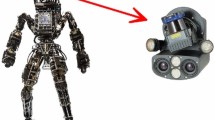Abstract
We consider a model of a 24-degree-of-freedom monkey robot that is supposed to perform a brachiation locomotion, i.e. to swing from one row of a horizontal ladder to the next one using the arms. The robot hand is constructed as a planar hook so that the contact point, about which the robot swings, is a passive hinge. We identify the 10 most relevant degrees of freedom for this underactuated mechanical system and formulate a tractable search procedure consisting on the following steps: (a) to introduce a parametrized family of coordination patterns to be enforced on the dynamics with respect to a path coordinate; (b) to formulate geometric equality constraints that are necessary to achieve a periodic locomotion; (c) to generate trajectories from integrable reduced dynamics associated with the passive hinge; (d) to evaluate the energetic cost of transport. Moreover, we observe that a linear approximation of the reduced dynamics can be used for trajectory generation, which allows us to incorporate computation of an approximate gradient of the cost function into the search algorithm significantly improving the computational efficiency.




















Similar content being viewed by others
Notes
Most of dissipative forces appear in actuated joints and can be compensated by an appropriate feedback action.
References
Aoyama, T., Kobayashi, T., Lu, Z., Sekiyama, K., Hasegawa, Y., & Fukuda, T. (2012). Locomotion transition scheme of multi-locomotion robot. Injury and Skeletal Biomechanics (pp. 21–36). New York: INTECH
Chevallereau, C., & Aoustin, Y. (2001). Optimal reference trajectories for walking and running of a biped robot. Robotica, 19(5), 557–569.
Chevallereau, C., Bessonnet, G., Abba, G., & Aoustin, Y. (2009). Bipedal robots: Modeling, design and walking synthesis. New York: Wiley.
Fleagle, J. (1974). Dynamics of a brachiating siamang [hylobates (symphalangus) syndactylus]. Nature, 248, 259–260.
Fukuda, T., Hasegawa, Y., Sekiyama, K., & Aoyama, T. (2012). Multi-locomotion robotic systems—New concepts of bio-inspired robotics. Springer Tracts in Advanced Robotics. New York: Springer
Fukuda, T., Hosokai, H., & Kondo, Y. (1991). Brachiation type of mobile robot. In Proceedings of the IEEE international conference on advanced robotics, Pisa, Italy.
Fukuda, T., Saito, F., & Arai, F. (1991). A study on the brachiation type of mobile robot (heuristiccreation of driving input and control using CMAC). In Proceedings of the IEEE/RSJ International Conference onIntelligent Robots and Systems, Osaka, Japan.
Gomes, M., & Ruina, A. (2011, March). Walking model with no energy cost. Physical Review E, 83, 032901. doi:10.1103/PhysRevE.83.032901.
Gusev, S., Johansson, S., Kågström, B., Shiriaev, A., & Varga, A. (2010). A numerical evaluation of solvers for the periodic Riccati differential equation. BIT Numerical Mathematics, 50(2), 301–329.
Kajima, H., Hasegawa, Y., Doi, M., & Fukuda, T. (2006). Energy-based swing-back control for continuous brachiation of a multilocomotion robot. International Journal of Intelligent Systems, 21, 1025–1043.
LaValle, S. M. (2006). Planning algorithms. Cambridge: Cambridge University Press.
McGeer, T. (1990). Passive dynamic walking. The International Journal of Robotics Research, 9(2), 62–82.
Mettin, U., La Hera, P., Freidovich, L., Shiriaev, A., & Helbo, J. (2008). Motion planning for humanoid robots based on virtual constraints extracted from recorded human movements. Journal of Intelligent Service Robotics, 1(4), 289–301.
Parsons, P., & Taylor, C. (1977). Energetics of brachiation versus walking: A comparison of a suspended and an inverted pendulum mechanism. Physiological Zoology, 50(3), 182–188.
Pchelkin, S., Shiriaev, A., Freidovich, L., Mettin, U., Gusev, S., Kwon, W., et al. (2014). A dynamic human motion: Coordination analysis. Biological Cybernetics. doi:10.1007/s00422-014-0624-4.
Preuschoft, H., & Demes, B. (1984). Biomechanics of brachiation. Edinburgh: Edinburgh University Press.
Saito, F., Fukuda, T., & Arai, F. (1994). Swing and locomotion control for a two-link brachiation robot. IEEE Control Systems Magazine, 14(1), 5–12.
Shiriaev, A., & Freidovich, L. (2009). Transverse linearization for impulsive mechanical systems with one passive link. IEEE Transactions Automatic Control, 54(12), 2882–2888.
Shiriaev, A., Freidovich, L., & Gusev, S. (2010). Transverse linearization for controlled mechanical systems with several passive degrees of freedom. IEEE Transactions on Automatic Control, 55(4), 893–906.
Shiriaev, A., Perram, J., & Canudas-de-Wit, C. (2005). Constructive tool for orbital stabilization of underactuated nonlinear systems: Virtual constraints approach. IEEE Transactions on Automatic Control, 50(8), 1164–1176.
Spong, M., Hutchinson, S., & Vidyasagar, M. (2006). Robot modeling and control. New York: Wiley.
Tlalolini, D., Chevallereau, C., & Aoustin, Y. (2011). Human-like walking: Optimal motion of a bipedal robot with toe-rotation motion. IEEE/ASME Transactions on Mechatronics, 16(2), 310–320.
Westervelt, E., Grizzle, J., Chevallereau, C., Choi, J., & Morris, B. (2007). Feedback control of dynamic bipedal robot locomotion. Boca Raton: CRC Press, Taylor & Francis Group.
Acknowledgments
We would like to thank Professor Toshio Fukuda for suggesting the problem and for providing us with technical characteristics of the 24-degrees-of-freedom Gorilla robot built at the Nagoya University, Japan and to acknowledge valuable discussions with Toshio Fukuda, Tadayoshi Aoyama, and Zhiguo Lu.
Author information
Authors and Affiliations
Corresponding author
Rights and permissions
About this article
Cite this article
Pchelkin, S.S., Shiriaev, A.S., Mettin, U. et al. Algorithms for finding gaits of locomotive mechanisms: case studies for Gorilla robot brachiation. Auton Robot 40, 849–865 (2016). https://doi.org/10.1007/s10514-015-9497-1
Received:
Accepted:
Published:
Issue Date:
DOI: https://doi.org/10.1007/s10514-015-9497-1




